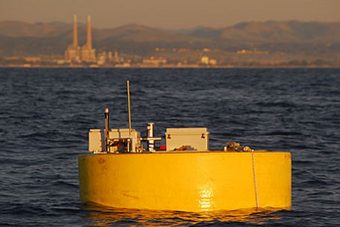
MBARI engineer Andy Hamilton looks out his office window in Moss Landing and points at the waves crashing on the beach below. “Pretty impressive, aren’t they? You’d think there’d be a way to make use of all that energy.”
Since 2009, Hamilton has led a team of engineers trying to do just that. Their goal is not to replace the hulking power plant that overlooks Moss Landing Harbor, but to provide a more generous supply of electricity for oceanographic instruments in Monterey Bay.
Hamilton’s “power buoy” project was initially funded by the Defense Advanced Research Projects Agency (DARPA), which sponsors research into revolutionary new technologies that might one day be used by the U.S. military. The project started with a three-month grant to assess the availability of wave power around the world, and to assess DARPA’s previous attempts to generating electrical power from the waves.
Hamilton’s initial research and calculations showed that DARPA’s previous efforts had been too timid—their small prototype buoys were never able to take advantage of the full energy of the waves. So Hamilton proposed to “go big” (but not as big as commercial wave-power projects).
Because most wave motion occurs at the sea surface, the buoy rises and falls with the waves, but the plate, 30 meters (100 feet) down, remains relatively stationary. Between the surface buoy and the metal plate is a large hydraulic cylinder with a piston inside. As the buoy rises and falls, it pushes and pulls on this piston. This forces hydraulic fluid through a hydraulic motor, which in turn runs an electrical generator.
One of the first challenges the team faced was figuring out the best way to convert the vertical motion of the waves into rotary motion that could power a generator. First they bought a custom-made generator from an outside company, but that turned out to be too inefficient to be useful. Going back to the drawing board, the team designed their own system using an off-the-shelf hydraulic motor similar to those used on earth-moving equipment and on MBARI’s underwater robots. These hydraulic motors use moving hydraulic fluid to drive a rotating shaft with up to 95 percent efficiency.
Another challenge that Hamilton’s team faced was designing a mechanism that would return the piston to its starting point after a wave had passed. Hamilton initially envisioned using a large metal spring for this purpose, but the metal spring turned out to be much too heavy. So the team redesigned the system to incorporate a pneumatic spring—a chamber filled with nitrogen gas, and mounted at one end of the piston. As the piston moves with the waves, it compresses or decompresses the nitrogen gas in the chamber. After the wave passes, the gas in the chamber returns to its original pressure, forcing the piston back to the middle of its stroke.
Source: MBARI
